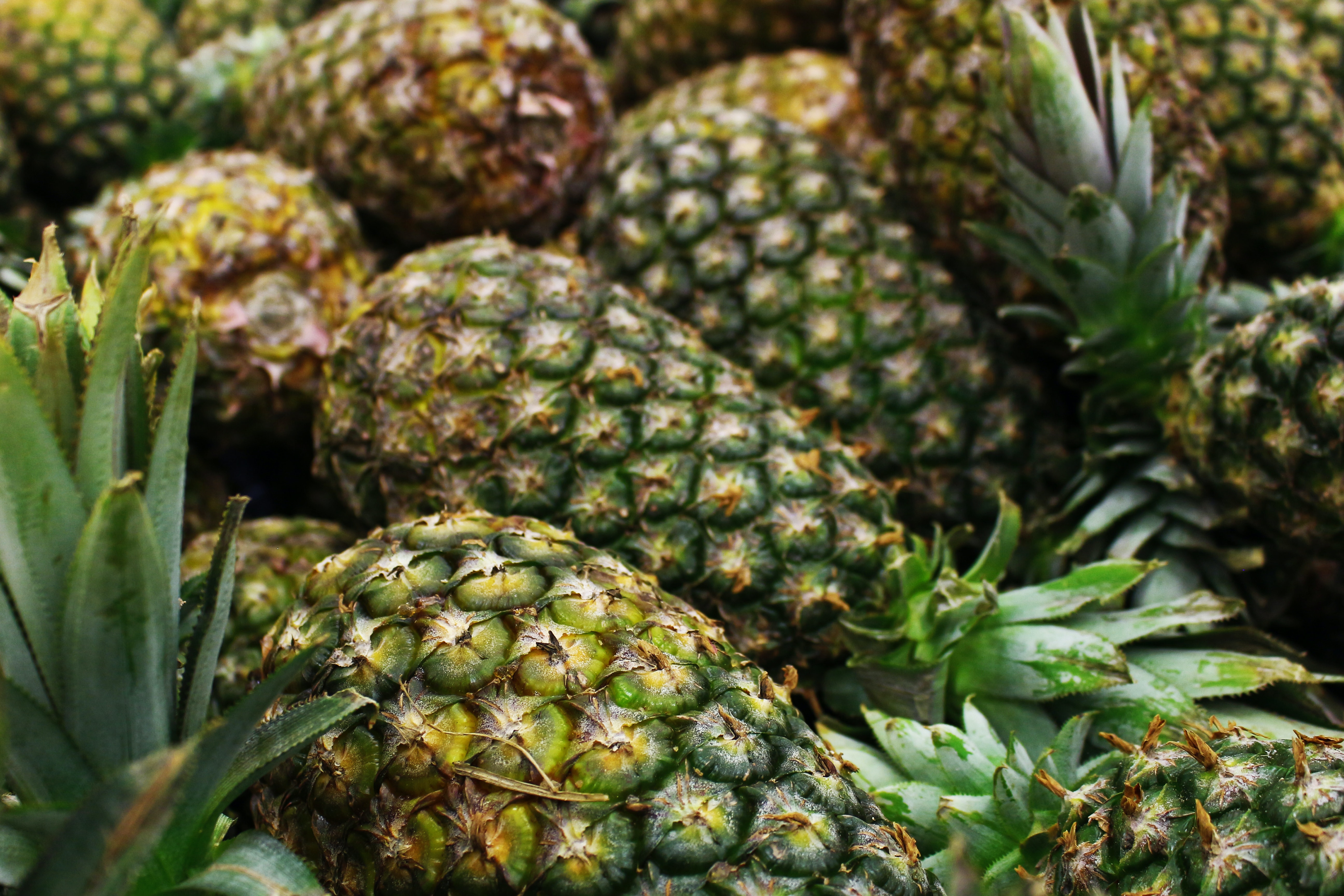Pineapple Harvesting, Handling, Storage, and Selling

This post is also available in:
This post is also available in:
![]() Español (Spanish)
Español (Spanish) ![]() Français (French)
Français (French) ![]() Deutsch (German)
Deutsch (German) ![]() हिन्दी (Hindi)
हिन्दी (Hindi) ![]() العربية (Arabic)
العربية (Arabic) ![]() Türkçe (Turkish)
Türkçe (Turkish) ![]() 简体中文 (Chinese (Simplified))
简体中文 (Chinese (Simplified)) ![]() Português (Portuguese (Brazil))
Português (Portuguese (Brazil))
Pineapple is a non-climacteric fruit whose quality, such as the total amount of sugars known as total soluble solids (TSS) and taste, does not increase after harvesting. The taste and sweetness of pineapples picked at more advanced maturation stages (ripened on the plant) are much superior to those of less mature fruit.
Harvesting is usually performed after more than 3 months from flower induction (1). It is, however, difficult to determine when the pineapple is ripe for harvesting. Therefore, using an index for harvesting fruits is particularly important, as it allows farmers to harvest the best fruits for their market. One of the indices is when the color of the peel changes from green to yellow by at least 1/3-2/3 (Hossain,2016). However, this harvest indicator highly depends on the cultivar and market goal. Picking the fruits can be done manually or semi-mechanized, and here are some of the most important things to do to protect the quality of the harvested fruits.
- Approximately at least 2.5 centimeters of the peduncle should be left attached to the fruit when it is cut during harvest (2).
- Care must be taken when picking and gathering fruit in the field, not damaging them because they can lose their quality and shorten their post-harvest life. Any misformed or diseased-damaged fruits should be discarded already from the field.
- The crown can sometimes be removed if the product is sold in the local market to save the crowns for replanting, but they are always maintained for export markets.
- The fruits should not be left in the field long after harvest. Instead, they should be gathered on trucks and transferred to the packing house as soon as the harvest is finished.
It is also important to mention that there is a global index that acts as a guide for international markets to regulate the quality of pineapples to be sold. In pineapples, this indicator is called the global Codex Alimentarius Standard for Pineapple; the TSS level at harvest must be greater than 12 °Brix and contain 1% of maximum acidity as set by CODEX and FAO/WHO for international trade (3). Only pineapples meeting these criteria are accepted for exportation.
Post-harvest management
Post-harvest management is critical to preserving what a farmer has invested in resources and time in the field. In order to increase the products’ self-life, the farmer or storage manager should follow the steps and processes mentioned below.
a. Grading
Before grading, the fruits are washed upon arrival from the field, and the processes of waxing to reduce dehydration of the fruits and fungicide treatment follows. The fruits should be left to dry and graded according to their size and ripening level. Then they are grouped according to grading and packed. At this stage, fruits that do not qualify can be left to be sold in the local market.
b. Precooling
It is important to note that heat accelerates metabolic processes in fruits, which intensify the production of ethylene as well as the dehydration of the fruits. As such, it is recommended to pre-cool the fruits before packing. This allows the fruit to cool down rapidly to the required storage temperature.
c. Storage
Pineapples should be refrigerated after picking to maintain their freshness. If fruits are to be transported for more than three days, they should be refrigerated at temperatures ranging from 7.1 to 10° C (44.78° F -50°F) if they are to be transported for more than 3 days (4).
Pineapples Selling and Exporting
For better planning, it is always essential for a farmer to know the market standards and options for pineapples, even before starting the plantation. Pineapples can be sold at local markets and exported. Both have their own requirements for market acceptance and maintaining the fresh quality of the fruits.
As for the international market, more than 50% of all fresh fruit imported worldwide is consumed in Europe and North America, making it a prime target for expanding producers. Concerns about health and a growing desire for vegan options are driving up demand for fresh fruit throughout the developed world. European demand for pineapples has risen recently, and several tropical countries can meet that need. Countries like Costa Rica and the Philippines are major exporters of pineapple, while the United States, the Netherlands, and German are major buyers (5).
The following are the minimum requirements for exportation to Europe (6). Based on these, the fruits should be:
- intact, with or without a crown, and if there is a crown, it should be reduced. Pineapples should not have any scars or bruising, cracks, or mechanical damage that might lower their quality.
- in good condition without any rotting or deterioration that could render it unfit for consumption, especially when this is due to diseases, physiological disorders, or serious deterioration that noticeably affects their appearance, edibility, or other factors.
- clean, with almost no foreign matter that can be seen; pineapples must have almost no chemical residues, dust, soil, or other foreign matter.
- practically free from pests. The acceptable limit would be a single insect, mite, or other pest in the sample or package; any colonies would lead to the rejection of the produce.
- free of damage caused by pests to the flesh; damage to the flesh caused by pests makes the food unsafe to eat and is not allowed.
- both the fruit and the crown, if present, should be firm and turgid because any signs of drying out or shrinking, or having crowns with leaves that are wilted or dry, are not allowed.
- free of abnormal external moisture, which applies to excessive moisture, for example, free water lying inside the package, but does not include condensation on produce following release from cool storage or a refrigerated vehicle.
- free of any foreign odors or tastes. This problem may arise when the fruits are poorly and closely stored and transported to other products that give off volatile odors.
It is also important to establish a protocol for quality assurance of the fruits, which usually involves measuring the following parameters (7):
- Brix level (total soluble solids), which is easily ascertainable using a hand-held refractometer (an easily found instrument).
- Firmness of fruit, which is measured with a penetrometer
- pH is measured with a pH meter and for the fruit to meet the international market’s requirement of 1 degree of acidity.
- The pulp temperature will be determined using a probe thermometer.
- Weight, which can be done manually or automatically depending on the production level.
- Size for easy grading.
Packaging
Pineapples for exportation should always be packaged without detaching the fruit from the crown, which benefits both the shelf life and the prevention of infection at the crown attachment point. Pineapples can be packed horizontally or vertically in the boxes, keeping the crown on the top side. The packages should be marked, including the following information.
a) The identification of the shipper or packer, together with the code mark, indicates the person or business responsible for packing the product (not the workers, who are solely liable to their employer).
b) The package should be labeled pineapple as well as the variety with a clear indication of the presence or absence of the crown.
c) The country of origin, including the local address, should be indicated.
d) Stating the classification of the fruits, which are Extra class (for fruits of superior quality), Class 1 (with good quality fruits with a single crown if present), and class 2 (including fruits that do not qualify the first 2 class but meet the minimum requirement for exportation).
References
[1] Hossain, M. F. (2016). World pineapple production: An overview. African Journal of Food, Agriculture, Nutrition and Development, 16(4), 11443-11456. https://www.ajol.info/index.php/ajfand/article/view/149223
[2] Agricultural Standards Unit of United Nations Economic Commission for Europe. (2013). UNECE Standard on the marketing and commercial quality control of pineapples. https://unece.org/fileadmin/DAM/trade/agr/promotion/Brochures/Pineapples/LowResolution_Pineapples_Eng.pdf
[3] Office of Gene technology regulator (Government of Australia).(2008). The Biology of
Ananas comosus var. comosus.
(Pineapple). https://www.ogtr.gov.au/sites/default/files/files/2021-07/the_biology_of_pineapple.pdf
[4] Bartholomew, D.P., Paull, R.E. and Rohrbach, K.G. (2003). The Pineapple: Botany, Production and Uses. CABI, Wallingford.
https://doi.org/10.1079/9780851995038.0000
[5] Lobo, M. G., & Siddiq, M. (2017). Overview of pineapple production, post-harvest physiology, processing, and nutrition. Handbook of Pineapple Technology: Production, Postharvest Science, Processing and Nutrition, 1-15. https://books.google.com/
[6] Agricultural Standards Unit of United Nations Economic Commission for Europe. (2013). UNECE Standard on the marketing and commercial quality control of pineapples. https://unece.org/fileadmin/DAM/trade/agr/promotion/Brochures/Pineapples/LowResolution_Pineapples_Eng.pdf
[7] Joy P.P. (n.d). Protocol for pineapple export. https://kau.in/sites/default/files/documents/protocol_for_export_of_pineapple.pdf
Pineapple History, Uses and Nutritional Value
Pineapples Plant Information and Environmental Requirements
Soil Requirements and Land Preparation for Pineapple
Planting of Pineapple – Pineapple Plant Density
Pineapple Water Needs and Irrigation Systems
Pineapple Fertilization Requirements
Pineapple Flowering, Pollination, and Pruning
Pineapple Harvesting, Handling, Storage, and Selling








































































